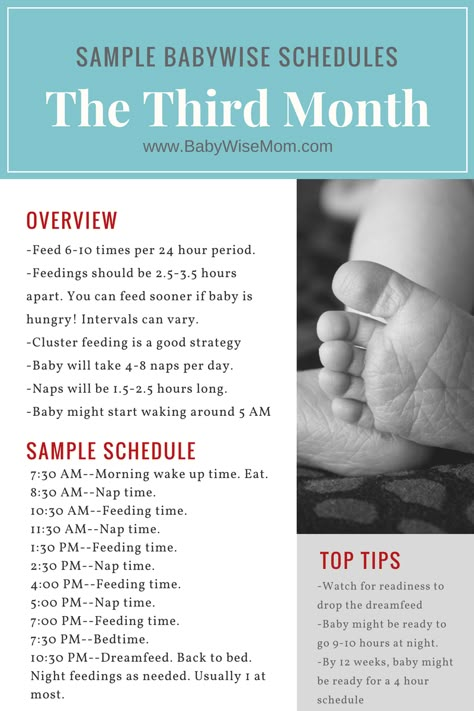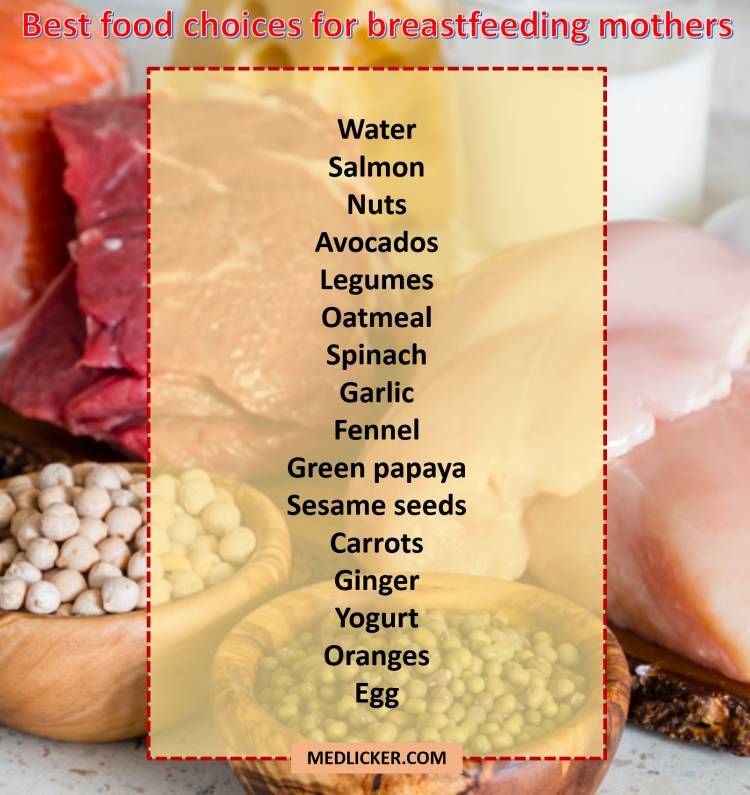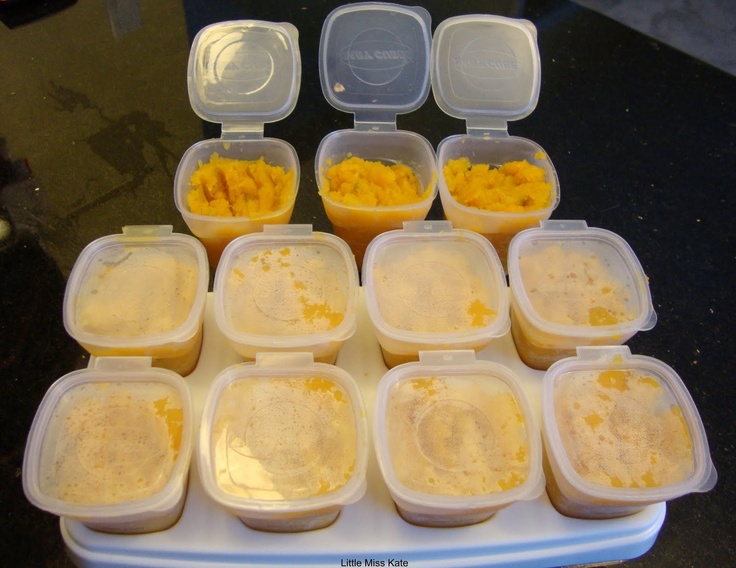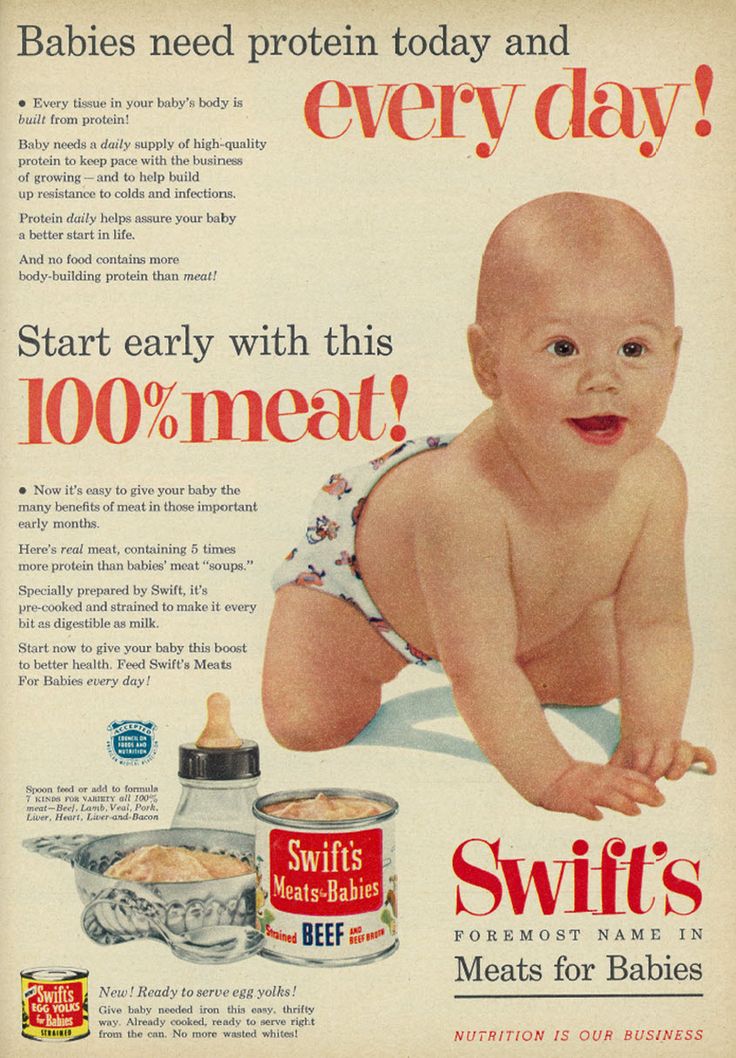Sample baby feeding schedule
Tips for the First Year
Eat, sleep, pee, poop, repeat. Those are the highlights in a day of the life of a brand new baby.
And if you’re a new parent, it’s the eating part that may be the source of many of your questions and worries. How many ounces should your baby take? Do you wake a sleeping baby to eat? Why do they seem hungry all the time? When can your child start solids?
Questions abound — and, despite Grandma’s insistence, the answers have changed since you were a tot. It’s now recommended that newborns, even formula-fed ones, eat on demand (consider it good preparation for the teenage years) and that babies wait to start solid foods until they’re 4 to 6 months old.
On day one of life, your baby’s stomach is the size of a marble and can only hold 1 to 1.4 teaspoons of liquid at a time. As your baby gets older, their stomach stretches and grows.
It’s hard (or impossible, really) to know how much milk your baby is taking in while breastfeeding. But if you’re bottle feeding due to any number of valid reasons, it’s a bit easier to measure.
Here, from the American Academy of Pediatrics (AAP), a typical feeding schedule for bottle-fed babies.
| Age | Ounces per feeding | Solid foods |
|---|---|---|
| Up to 2 weeks of life | .5 oz. in the first days, then 1–3 oz. | No |
| 2 weeks to 2 months | 2–4 oz. | No |
| 2–4 months | 4-6 oz. | No |
| 4–6 months | 4–8 oz. | Possibly, if your baby can hold their head up and is at least 13 pounds. But you don’t need to introduce solid foods yet. |
| 6–12 months | 8 oz. | Yes. Start with soft foods, like one-grain cereals and pureed vegetables, meats, and fruits, progressing to mashed and well-chopped finger foods. Give your baby one new food at a time. Continue supplementing with breast or formula feedings.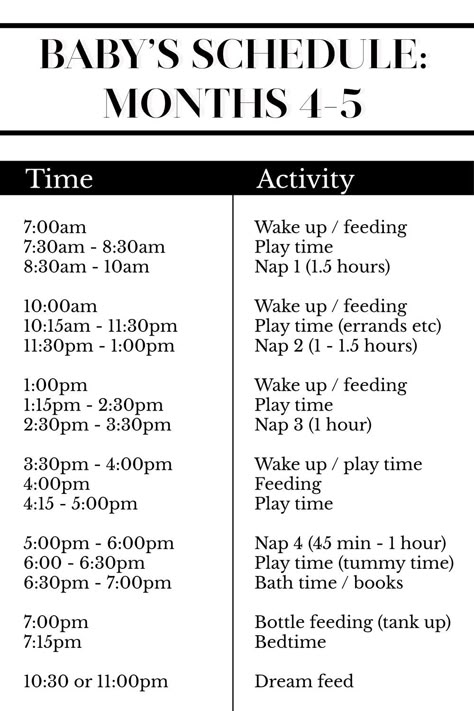 |
Every baby is unique — but one thing that’s pretty consistent is that breastfed babies eat more frequently than bottle-fed ones. That’s because breast milk is easily digested and empties from the stomach a lot quicker than formula.
Breastfed babies
There’s no rest for the weary. According to La Leche League International, you should begin nursing your baby within 1 hour of birth and provide about 8 to 12 feedings daily in the first few weeks of life (yeah, we’re exhausted for you).
At first, it’s important not to let your baby go more than 4 hours without feeding. You’ll likely need to wake them up if necessary, at least until breastfeeding is well established and they’re gaining weight appropriately.
As your baby grows and your milk supply amps up, your baby will be able to take in more milk in less time at one feeding. That’s when you might start to notice a more predictable pattern.
- 1 to 3 months: Your baby will feed 7 to 9 times per 24 hours.

- 3 months: Feedings take place 6 to 8 times in 24 hours.
- 6 months: Your baby will feed around 6 times a day.
- 12 months: Nursing may drop to about 4 times a day. The introduction of solids at about 6 months helps to fuel your baby’s additional nutritional needs.
Keep in mind that this pattern is just one example. Different babies have different paces and preferences, along with other factors that influence the frequency of feedings.
Bottle-fed babies
Like breastfed babies, bottle-fed newborns should eat on demand. On average, that’s about every 2 to 3 hours. A typical feeding schedule may look like this:
- Newborn: every 2 to 3 hours
- At 2 months: every 3 to 4 hours
- At 4 to 6 months: every 4 to 5 hours
- At 6+ months: every 4 to 5 hours
For both breastfed and bottle-fed babies
- Don’t give liquids other than formula or breast milk to babies under a year old. That includes juices and cow’s milk.
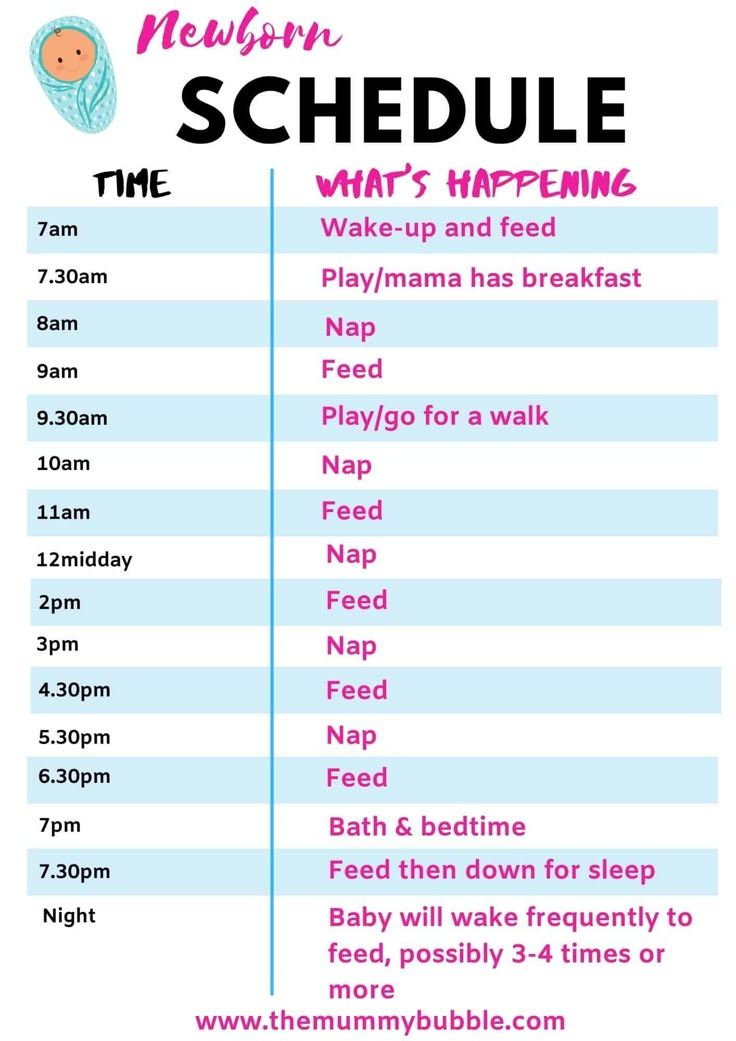 They don’t provide the right (if any) nutrients and can be upsetting to your baby’s tummy. Water can be introduced around 6 months when you start offering a cup.
They don’t provide the right (if any) nutrients and can be upsetting to your baby’s tummy. Water can be introduced around 6 months when you start offering a cup. - Don’t add baby cereal to a bottle.
- It can create a choking hazard.
- A baby’s digestive system isn’t mature enough to handle cereal until about 4 to 6 months of age.
- You could overfeed your baby.
- Don’t give your baby any form of honey until after their first birthday. Honey can be dangerous for a baby, occasionally causing what’s called infant botulism.
- Do adjust your expectations based on your baby and their unique needs. Premature babies are likely to follow feeding patterns according to their adjusted age. If your baby has challenges like reflux or failure to thrive, you may need to work with your doctor on the appropriate feeding schedule and amount they should be eating.
Schedules are the holy grail of every parent. Your child will naturally start to fall into a feeding pattern as their tummy grows and they can take in more breast milk or formula at one sitting. This may begin to happen between 2 and 4 months of age.
This may begin to happen between 2 and 4 months of age.
For now, though, focus on learning your baby’s hunger cues, such as:
- rooting around your chest, looking for a nipple.
- putting their fist in their mouth
- smacking or licking their lips
- fussing that can escalate quickly (don’t wait until your baby’s hangry to feed them)
Once your baby is a few months old, you may be able to introduce a sleep/feed schedule that works for you.
Let’s say, for example, your 4-month-old wakes every 5 hours for a feeding. That means if you feed at 9 p.m., your baby wakes around 2 a.m. But if you wake and feed the baby at 11 p.m., just before you go to bed, they may not rouse until 4 a.m., giving you a decent chunk of nighttime winks.
In general, if your baby seems hungry, feed them. Your baby will naturally eat more frequently during growth spurts, which typically occur around 3 weeks, 3 months, and 6 months of age.
Some babies will also “cluster feed,” meaning they’ll feed more frequently during certain periods and less at others.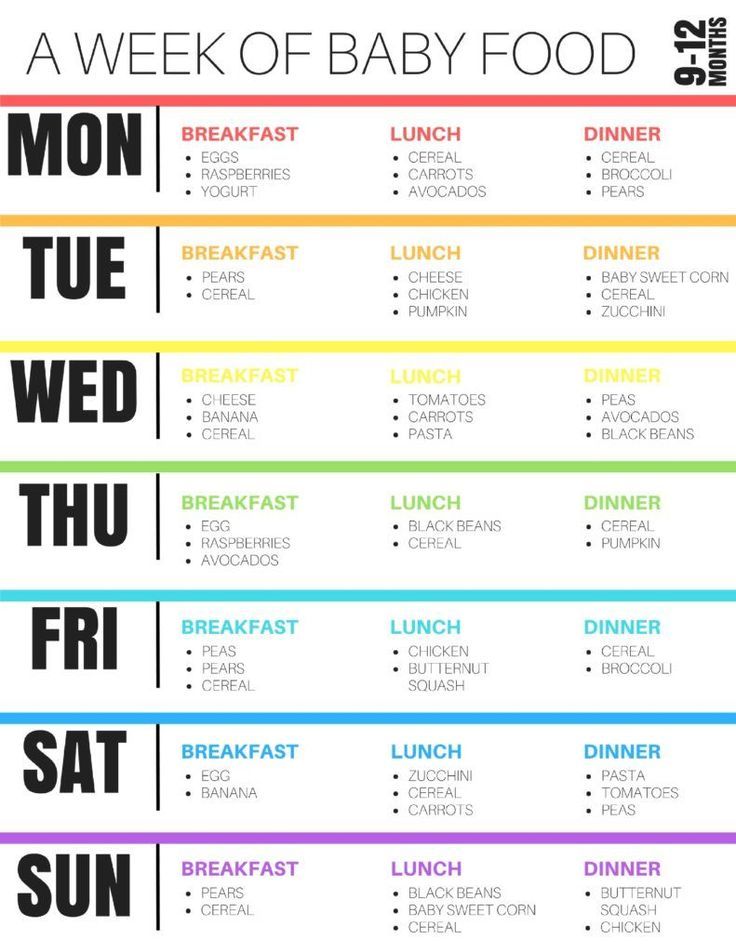 For example, your baby may cluster feed during the late afternoon and evening and then sleep longer at night (yay!). This is more common in breastfed babies than bottle fed babies.
For example, your baby may cluster feed during the late afternoon and evening and then sleep longer at night (yay!). This is more common in breastfed babies than bottle fed babies.
Worried about overfeeding? While this isn’t really possible to do with an exclusively breastfed baby, you can overfeed a baby who’s taking a bottle — especially if they’re sucking on the bottle for comfort. Follow their hunger cues, but talk to your pediatrician if you’re worried your little one may be overeating.
Your baby is probably ready for solids if they’re 4 to 6 months old and:
- have good head control
- seem interested in what you’re eating
- reach for food
- weigh 13 or more pounds
Which food to start with? The AAP now says it doesn’t really matter much in what order you introduce foods. The only real rule: Stick with one food for 3 to 5 days before offering another. If there’s an allergic reaction (rash, diarrhea, vomiting are common first signs), you’ll know which food is causing it.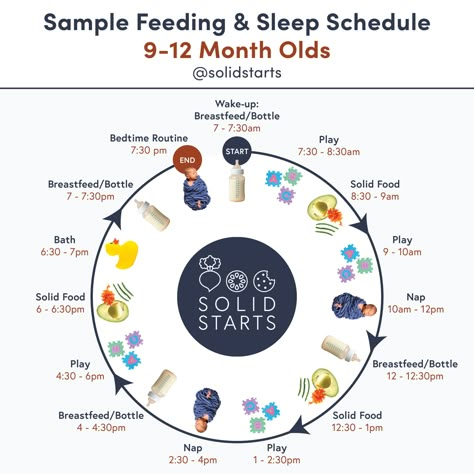
As your baby grows, move from pureed baby food to ones that have more texture (for example, mashed banana, scrambled egg, or well-cooked, chopped pasta). This generally happens around 8 to 10 months of age.
Your supermarket offers a variety of baby food products, but if you want to make your own, keep it sugar and salt free. Additionally, at this stage, don’t feed your baby anything that could be a choking hazard, including:
- hard foods, such as popcorn or nuts
- hard, fresh fruits, like apples; cook to soften or chop into very small pieces
- any meat that isn’t well cooked and very well chopped (this includes hot dogs)
- cheese cubes
- peanut butter (though talk to your pediatrician about this one — and the benefits of introducing diluted peanut butter before the age of 1)
As your baby nears their first birthday, they should be eating a variety of foods and taking in about 4 ounces of solids at each meal. Continue to offer breast milk or formula.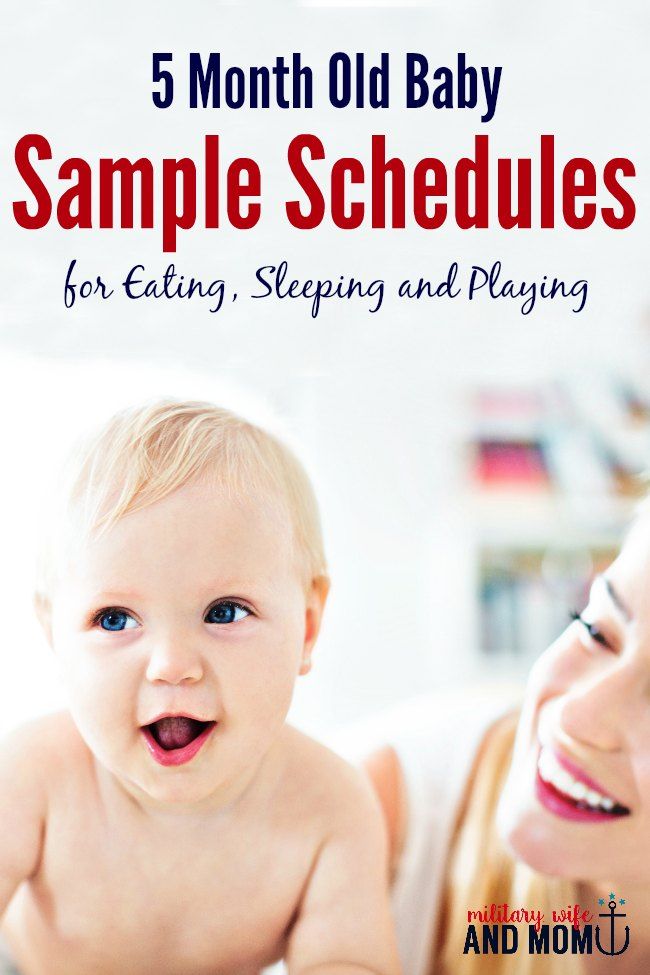 By 8 months, babies are drinking about 30 ounces a day.
By 8 months, babies are drinking about 30 ounces a day.
Oh yeah, and buy some stock in a company that makes stain-fighting laundry detergent. It’ll pay for college.
Babies aren’t cookie cutter. Some will gain weight easily, while others will have problems. Things that can affect a baby’s weight gain include:
- having a birth defect like a cleft lip or palate, which creates problems feeding
- having a milk protein intolerance
- being premature
- being fed with a bottle versus the breast
A 2012 study of more than 1,800 babies found that the infants who were fed with a bottle — regardless of whether the bottle contained breast milk or formula — gained more weight in the first year than babies who nursed exclusively.
Your baby’s doctor is the best one to advise you on a healthy weight range for your baby.
How, when, and what to feed a baby are top worries of every parent — but there’s good news: Most babies are pretty good judges of when they’re hungry and when they’re full — and they’ll let you know it.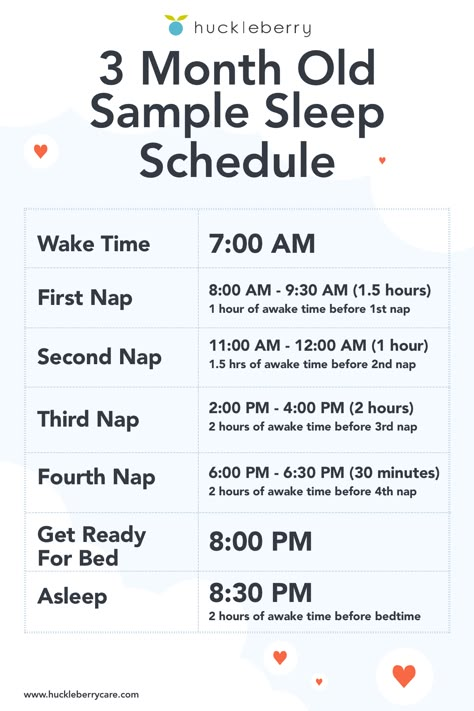
You just need to present them with the right choices at the right time and pay attention to their cues. If you have any questions or concerns, your pediatrician is there to help you along the way.
Example 6 Month Old Feeding Schedule
As you make the transition to introducing solid foods around six months, life starts to change!
The thought of introducing new foods on top of breast milk or formula and naps can leave even the calmest of new parents apprehensive.
Here are some things to keep in mind as you start to introduce those first foods to your baby, and a sample schedule to help you wrap your head around what to do!
More: For more help with baby led weaning and how to help your baby succeed with eating, be sure to check out this article with a comprehensive guide to baby led weaning and first baby foods!
6 month old baby’s feeding schedule pointers
Before we get to the actual schedule, here are a few things to keep in mind.
When to Start Solid Foods With Baby
The American Academy of Pediatrics recommends starting solid foods around 6 months. In this case solid food means traditional baby food or baby led weaning style finger foods. Really, anything other than breast milk or infant formula!
The best way to tell if your baby is ready to start solid foods is by following their developmental signs of readiness.
Once they are ready for foods, grab a good high chair, take a look at the schedule below, and you can start them with some modified table foods or a baby cereal and pureed foods.
Learn How to Set The Best Foundation For Feeding Your Baby!
Learning what to feed your baby is helpful. But what about all the rest?! Things like how they should be positioned for eating, what you should say at meals, and how to set up an environment that fosters a positive feeding relationship-for life!
These are the things your parents and friends don't have the answers for, and they're the things that make the biggest difference!
Grab the Foundations course where I walk you through it all.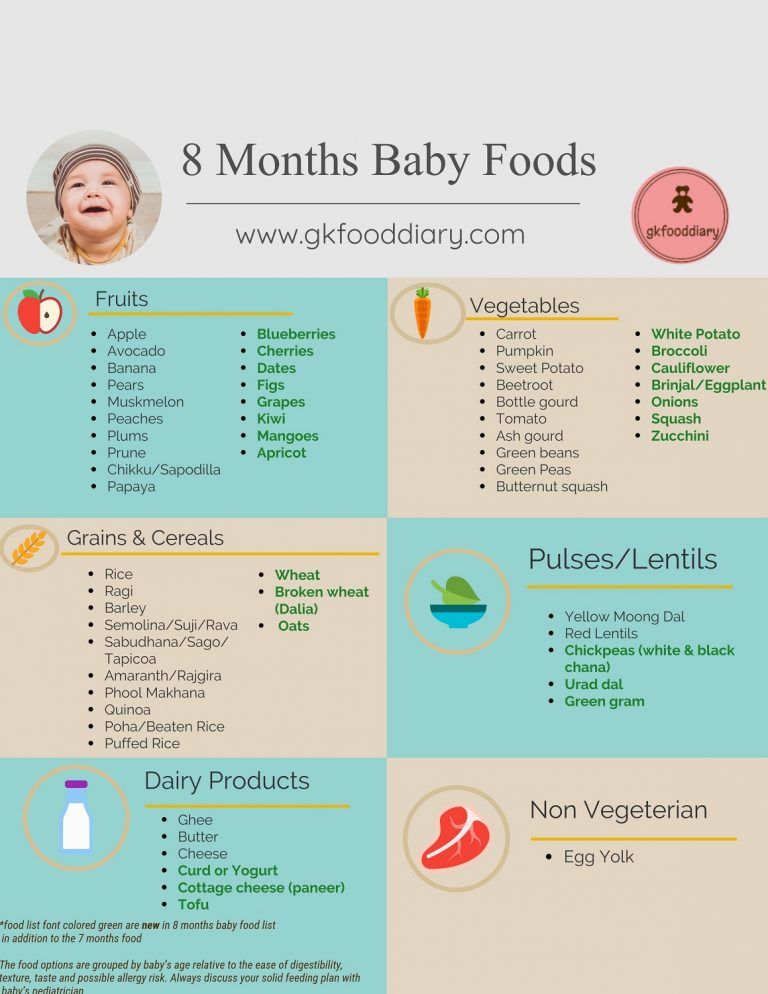
Breast Milk or Formula Is Still Their Primary Source of Nutrition
A 6 month old baby’s main source of nutrition is still going to be breast milk or formula. Introducing food is to help them get used to it, form a positive association with food, and to start getting some additional nutrients that they start to need right around that 6-month mark.
But your baby’s needs don’t all of a sudden change to where they need an additional three meals a day and a ton of food and eating opportunities!
The idea is to start slowly and follow your baby’s cues as you introduce more food and eating opportunities.
Keep giving breast milk or formula as you were before. That can mean on demand if you’re breastfeeding, or following the same general schedule you were before for formula-fed babies and breastfed babies.
Their amount of formula or breastmilk won’t necessarily change. The average baby at this time is usually going to be nursing 5-6 times a day, or taking 24-32 ounces of formula.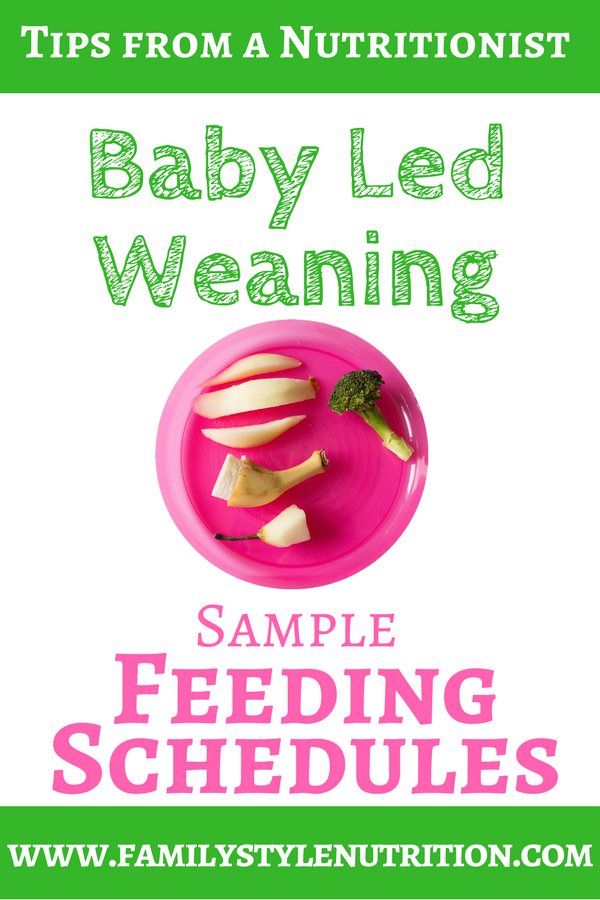 In many cases, it might actually increase because they are having growth spurts and will start to need more!
In many cases, it might actually increase because they are having growth spurts and will start to need more!
After you give them their breast milk or formula, add in a meal 30-60 minutes later. This doesn’t need to be set in stone, as what works for your baby might differ from someone else’s!
The general idea is to offer breast milk or formula first, give them a bit of a break, and then offer them solid foods.
Your 6 Month Old Baby Won’t Eat That Much!
At the beginning, babies take time to learn how to eat. Most babies will need to get the handle of how to get food to their mouth and down their throat. They won’t really be eating solid meals for several weeks in most cases.
Don’t panic if you’re a few weeks in and they still aren’t getting much solid food down. Give it some time. Remember, their primary source of nutrition is still their breast milk or formula!
And if you aren’t sure what to expect when it comes to solid foods, make sure to grab the Starting Solids course to help prepare you and give you confidence in feeding and to help you set up a great foundation for your feeding relationship with them.
Sample Feeding Schedule For A 6-Month-Old Baby
The biggest thing to keep in mind is that every baby is going to be different. I generally shy away from giving out specific schedules, because different things work for different babies.
But after many parents have asked consistently for it, here is an example schedule for your 6 month old to help you with a place to start for your daily routines.
I’m giving specific times to help you visualize it, but think of this more as a spacing example for your day than an exact example of when you should be doing these things.
A Note On Your Baby’s Sleep Schedule
All babies will have different sleep schedules. This is especially true for the first year of your baby’s life. Some babies will have a short nap in the morning, while others will take a long nap.
Sometimes that happens no matter how hard you try to maximize the hours of sleep your baby gets!
The best thing you can do is to be consistent in your wake windows.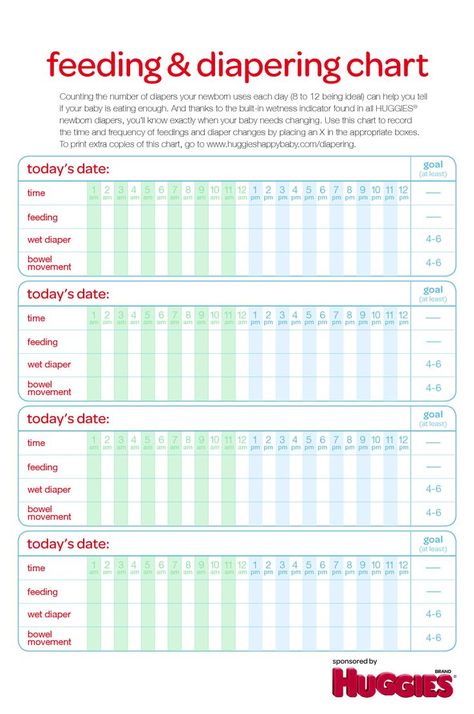 Meaning if your baby gets up at 7 am, you want to be consistent with something like a 2 hour wake window. This means that they will go back down for their first nap 2 hours after waking up.
Meaning if your baby gets up at 7 am, you want to be consistent with something like a 2 hour wake window. This means that they will go back down for their first nap 2 hours after waking up.
Follow this same pattern for their later naps and plan to put them down based on when they woke up, not necessarily the time the clock says.
As the day goes on, their wake window might get slightly longer. And as they grow, they will generally start to take longer naps and lengthen their wake time between naps.
Sample 6 Month Old Feeding Schedule With Breakfast
Here is an example of how I might space my day if I was planning to feed my baby solid foods at breakfast time. When they are first starting to eat and for the first several weeks of solid foods, they really do only need one meal a day.
Daily Schedule With Breakfast
- 6:30 am: Wake-up, then nurse or bottle
- 7:30-8:00 am: Breakfast (Head to this article for specific help with what to serve your baby at meals.
 )
) - 8:30 am: First morning nap
- 10:30 am: Nurse or bottle
- 12:00 pm: Second nap
- 1:30 pm: Nurse or bottle
- 4:00 pm: Third nap
- 5:00 pm: Nurse or bottle
- 6:30 pm: Nurse or bottle, then bedtime routine and sleep
Sample Feeding Schedule With Dinner
Here is a sample feeding schedule with dinner as your meal for the day. Again, this is just an example. To serve a different meal, simply aim to have the food 30-60 minutes after you have given them breast milk or formula.
You do not need to serve food at the same meal every day, or exactly at the same time. If your baby sleeps through your normal lunch time when you were planning to feed them, just plan to feed them at dinner.
I do recommend aiming to get in at least one meal a day once you start giving them solid foods to help them get in the practice that they need.
Daily Schedule With Dinner
- 6:30 am: Wake-up, then nurse or bottle
- 8:30 am: First morning nap
- 10:30 am: Nurse or bottle
- 12:00 pm: Second nap
- 1:30 pm: Nurse or bottle
- 4:00 pm: Third nap
- 5:00 pm: Nurse or bottle
- 5:30 pm: Dinner (Here are some dinner ideas for babies)
- 6:30 pm: Nurse or bottle, then bedtime routine and sleep
These Schedules Are Just Starting Places!
This is just a final reminder for you that these really are just places for you to start. Every baby and family will find a different flow that works for them.
Being consistent in wake windows is the most important thing at this age. Sleeping really is primary!
Sleeping really is primary!
A tired baby isn’t going to want to sit at the table and focus on learning how to eat. So do your best to let sleeping and breast milk or formula be the main concerns, and add in meals in between those.
As your baby gets older, the feeding schedule for 7 month olds really doesn’t change much.
They might drop a nap, have longer wake windows, and will likely start wanting to have more meals.
To increase meals to 2 a day, simply keep the same things in mind and add a meal 30-60 minutes after breast milk or formula when they are awake.
Looking for help on a feeding schedule for your toddler or 1-year-old? Check out this article with a sample 1 year old feeding schedule!
Daily routine for a child under 1 year old
Daily routine is a system for distributing periods of sleep and wakefulness, meals, hygiene and health procedures, activities and independent human activities throughout the day.
Compliance with a rational daily routine corresponding to the age characteristics of the child contributes to his healthy growth and development. Getting used to performing various types of activities at the same time, the child is prepared for the upcoming type of activity at every moment of time, which ensures their easier and faster implementation. Compliance with the correct daily routine provides a good mood for the child and maintains a keen interest in the study of the world around him, contributing to his normal motor and psychoverbal development.
The child's daily routine includes the following obligatory elements: diet, time spent outdoors during the day, frequency and duration of sleep, mandatory classes to develop skills in accordance with age, free time.
In the first months after birth, a healthy newborn baby sleeps for most of the day, since all external stimuli are very strong for the nervous system of a child, accustomed to a cozy intrauterine environment, and cause its rapid exhaustion. As the child grows older, the duration of sleep gradually decreases and the time of wakefulness increases.
As the child grows older, the duration of sleep gradually decreases and the time of wakefulness increases.
| Age | Daytime sleep mode | Night sleep | Wake mode |
| From birth to 2 months | 6 x 2.5 hours | 6 hours | During feeding |
| 2-4 months | 5 times 2-2.5 hours | 6.5 hours | 4 x 1.5 hours |
| 4-6 months | 4-5 times for 2 hours | 7 hours | 4 times 2 hours |
| 6-9 months | 3-4 times for 1.5-2 hours | 8 hours | 4 x 2.5 hours |
| 9-12 months | 2 x 1.5-2 hours | 9-10 hours | 4 times for 3-4 hours |
Closely related to the sleep-wake mode is the feeding mode of the baby. The sleep of a child in the first months of life is very sensitive and is easily disturbed under the influence of various extraneous stimuli, including hunger.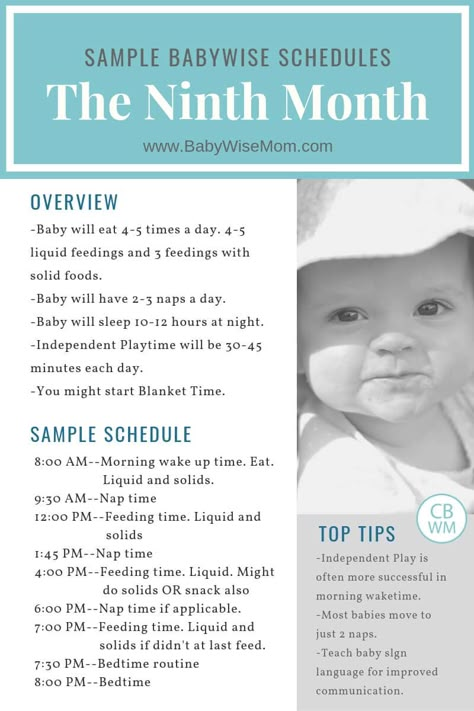
| Age | Mode | Example |
| From birth to 2 months | 7-8 times, every 3 hours | 6,9,12,15,18,21,24 (no night feeding) |
| From 2 to 6 months | 6-7 times, every 3.5 hours | 6, 9.30, 13, 16.30, 20, 23.30 (without night feeding) 6, 9.30, 13, 16.30, 20, 23.30, 03 (with night feeding) |
| From 7-12 months | 5 times, every 4 hours | 6,10,14,18,22 |
A child's stay in the fresh air is essential in the daily routine. The total duration of stay in the open air for children under 1 year of age should be at least 5-6 hours a day. Fresh air has a calming effect on the baby, improves metabolic processes, and increases the body's defenses. In the summer, all games and activities should be held outdoors; in the cold and transitional seasons, two one-time walks of 1. 5-2 hours are provided.
5-2 hours are provided.
Fresh air also has a beneficial effect on sleep. By acting on the skin and mucous membranes of the nose and upper respiratory tract, it provides a faster fall asleep of the child and a higher quality of sleep. Sleeping outside can replace a walk, especially during the cold season.
The child's daily routine is generally individual, but ideally, one should strive to ensure that the child eats after waking up, and then stays awake until the next sleep. A well-slept baby eats with appetite and then calmly and actively plays or engages, and tired of games, easily goes to sleep.
When your baby is awake, try to keep him active and cheerful. It is necessary to dress the child in loose clothing that does not hinder movement, provide access to toys appropriate for his age, and most importantly, actively participate in games and activities with the baby as a whole family.
Author - Physiotherapist - DMITRIENKO T.G.
Child's daily routine, nutrition, development at 6 months
04/19/2019
29
Approximate child's day routine
6 months
A 6-month-old child's daily routine is becoming more and more stable:
- A schedule is formed with predictable periods of daytime sleep.
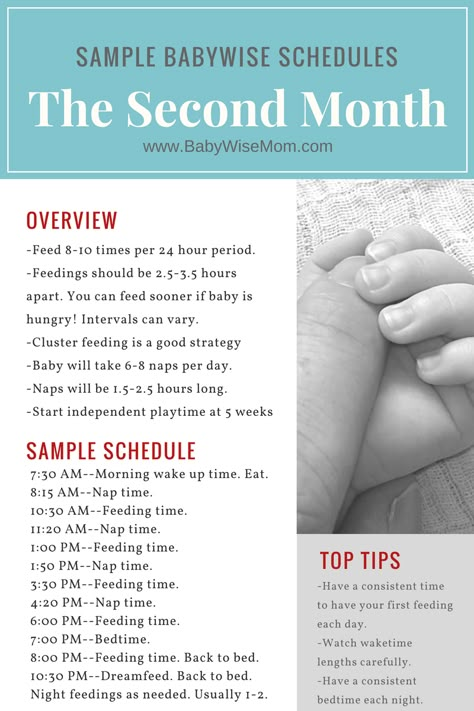
Some babies are comfortable with two naps during the day, others sleep three times a day until 8-9 months.
It is worth paying attention to the duration of daytime sleep - morning and afternoon sleep should be at least 1-1.5 hours long so that the child's body has a good rest. The third dream may remain short, it is better to start it between 15.00-16.00. Make sure that it does not end too late, otherwise the time for evening bedtime will shift. Morning and afternoon naps are recommended to be done at home, the third nap can be spent outside in a stroller.
When going to bed early, the best time to wake up in the morning is 06.30-07.00.
- Regular bedtime appears
A six-month-old baby is already physiologically ready for early bedtime. The optimal time for leaving at night will be between 18.00-20.00. You will have a clear bedtime ritual that will help the child relax and make the process of bedtime easier. The ritual must be repeated daily. It takes 20-30 minutes to complete it.
The ritual must be repeated daily. It takes 20-30 minutes to complete it.
- The period of wakefulness of the child increases
Now, when forming the daily routine, one should focus primarily on the recommended waking time - in six months it increases to 2.5 hours with an established regimen with three daytime sleeps. Signs of fatigue in a child are already harder to notice, so you can miss the moment when the baby is ready for bed.
Total amount of sleep
Now the child needs to sleep 13-14 hours a day. Night sleep is 11-12 hours with awakenings for 2-3 feedings while breastfeeding. The number of night awakenings in formula-fed babies will be less. The total duration of daytime sleep at this age is about 2.5-4 hours.
Monitor your baby's condition and follow the main recommendations of the table to understand how many hours of sleep he needs and correctly build a daily routine that will suit your six-month-old baby.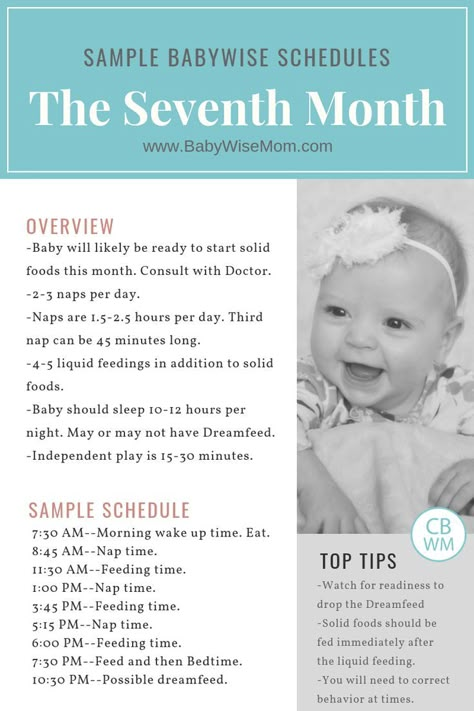
A table on the sleep and wakefulness of a child at 6 months will help you with this:
You can adjust the regime and adapt it as your baby grows in the Club MODE FROM A TO Z - read more.
What affects baby's sleep:
1. By 6 months, your baby has already learned to roll over from back to stomach and back. Now he is gradually mastering new skills: he learns to pull himself up at the support, get on all fours, sit on his own and actively prepare for crawling. The baby can continue to practice new skills both during the day and in the crib during sleep. At such moments, he often wakes up and sleeps restlessly. This is part of the natural development of the child.
To help him get used to the new possibilities of his body, practice new skills while awake. Show how you can lie back down from a sitting position. And if before the child did not mind spending a lot of time in the stroller, now he needs time and space for active play during wakefulness.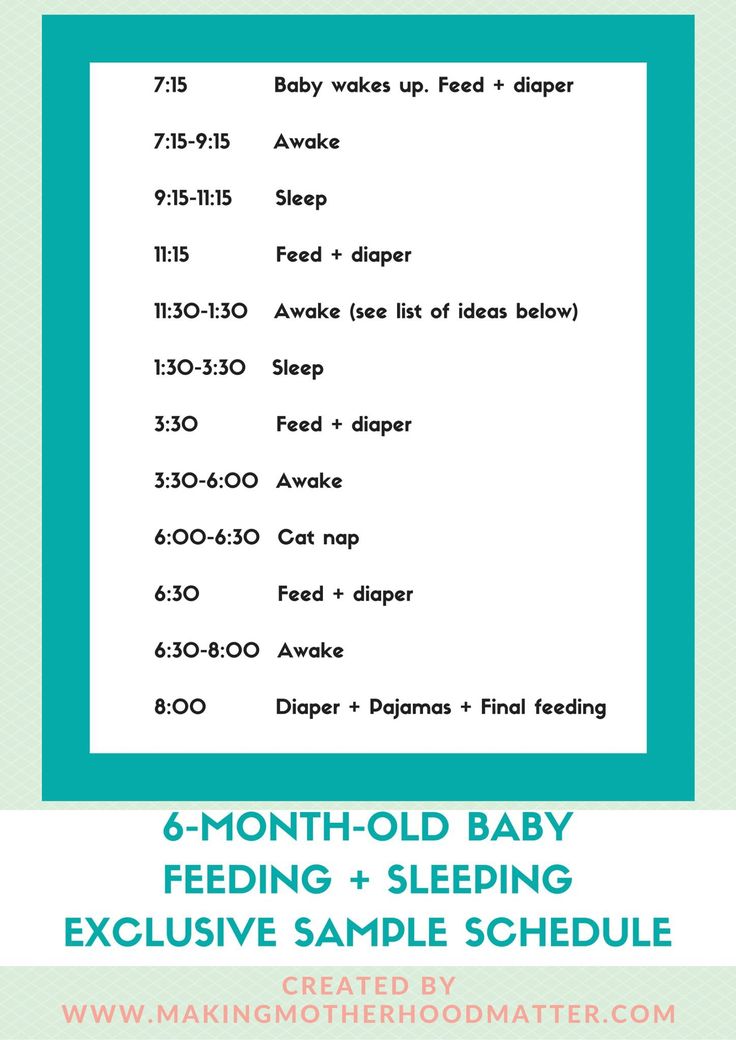 After 7-14 days, the child’s sleep will improve.
After 7-14 days, the child’s sleep will improve.
2. Skipping naps and going to bed too late at this age can lead to overtiredness, protests before bed and frequent nighttime awakenings. To prevent this from happening, try to follow a clear daily routine.
3. At six months, the baby may show the first signs of separation anxiety. Having become more independent, he realizes that he is not one with her. And the baby develops fear and anxiety that the mother will leave and will not return. If you find your baby won't let go of you during bedtime, extend the ritual to include carrying, massages, hugs, and kisses. Offer your child a sleep toy that smells like you and "guards" their sleep. It is also worth spending more time with the child one on one, without being distracted by other things.
4. Teething is another factor that affects the sleep of children of this age. In the acute period, help the baby in every possible way, use teething toys and anesthetic gel as recommended by your pediatrician. As soon as the acute period passes, return to the previous sleep conditions and daily routine.
As soon as the acute period passes, return to the previous sleep conditions and daily routine.
Watch the free workshop MY BABY SLEEPING BADLY AT NIGHT: 3 SOLUTIONS if your child is having trouble sleeping at night.
Child's diet
6 months
Breast milk and infant formula are still the main complete food for the baby, from which he receives important nutrients.
But at 5-6 months, you will notice that he has begun to show interest in adult food - watching you eat, following the spoon with his eyes, opening his mouth and smacking his lips. At six months, it is important to maintain this food interest in him, gradually expanding the child's nutrition. For this purpose, complementary foods are introduced. It is from the age of six months that WHO recommends including adult food in the diet of a breastfed child.
Complementary foods can be started with vegetable puree. Choose zucchini, cauliflower, broccoli.
Then gluten-free cereals are introduced. If the child is not gaining weight, then complementary foods usually begin with cereals.
Water is also added to the diet from 6 months. But modern pediatricians do not recommend giving juices to a child in the first year of life.
The volume of complementary foods is small - in the first days, half a teaspoon of mashed potatoes is enough for a baby, then the serving volume gradually increases over 10 days to the required norm. Feed one food and see how your baby reacts. The best feeding time is the first half of the day.
By the age of 6 months, the feeding regimen is formed. The child eats on awakening and shortly before bedtime up to 5-6 times a day. Attachments to the breast are short, as the child is often distracted during feeding. The most frequent feedings are in the evening and active sucking is shifted to the last 2-3 hours before waking up.
The amount and frequency of feedings should be discussed with the pediatrician.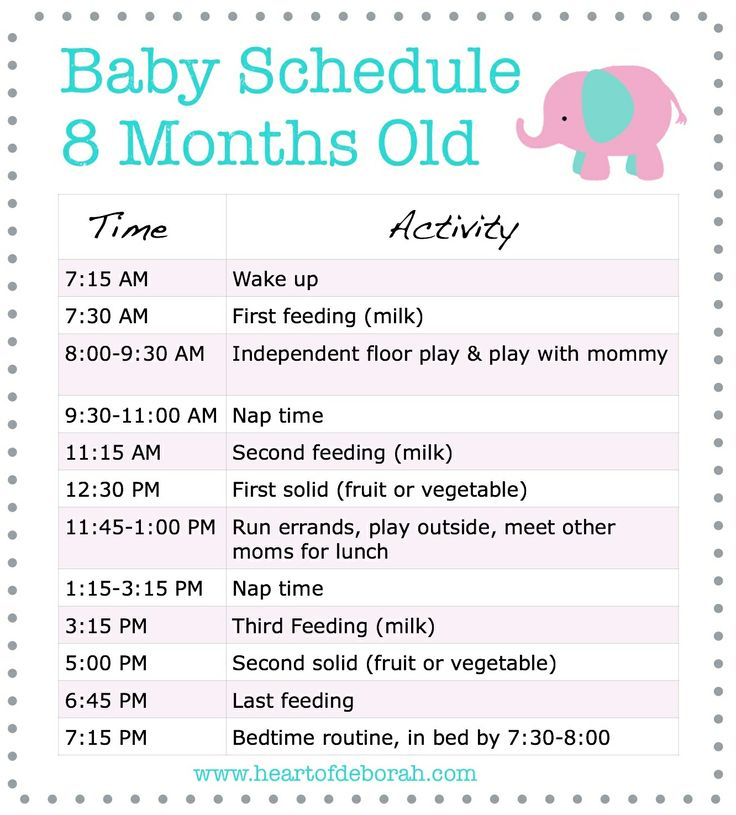
Development of the child
Thinking
The baby now distinguishes well between friends and strangers and can show his displeasure, being left without a mother.
Be prepared that the child will not want to let you go if you want to leave him with his grandparents.⠀
Communication
The kid already turns around at his name, listens to the voice of an adult and pronounces syllables in response to your voice.
Say his name as often as possible and name toys when communicating with your baby to develop his vocabulary.⠀
Physical development
Most likely your baby has already learned to roll over, master the skill of sitting and is preparing to crawl. Also, the child begins to transfer weight to the legs and can stand with the support of both hands. He stretches both hands to his mother, expressing a desire that she take him to her.